Panel 1
Federica Ferrigno, Fiorenzo Fumanti
In Italy, geothermal energy, renewable and sustainable, is concentrated in 10 concessions in Tuscany with 34 plants that, in 2023, produced 5,692 GWh, covering 31% of the regional demand and 70% of Tuscany's renewable energy sources.
The direct uses of geothermal heat (climate control, spa use, district heating) and geothermal heat pumps, about 20,000, are growing but still underutilized compared to Northern European countries. The environmental impact is limited and mitigated by abatement systems (AMIS) and reinjection of fluids. Italian resources, concentrated in the Tuscan-Lazio area, also show potential for recovery of strategic elements such as lithium, crucial for the energy transition.
Geothermal energy is the energy contained as heat within the Earth. Produced by the natural decay of radioactive elements, it is enormous and inexhaustible and dissipates diffusely toward the surface. Below the Earth's surface, the temperature increases on average by about 3°C every 100 m (geothermal gradient), but specific geological conditions such as the presence of buried magmatic bodies generate positive thermal anomalies that can create geothermal systems at technologically accessible depths, where the energy carrier is represented by circulating water in liquid and/or gaseous phase. In its industrial sense, geothermal energy refers to the portion of energy that can be extracted and utilized by humans. It can be used indirectly to generate electricity in the presence of aquifers at medium-high temperatures (85°C<T<350°C) and with different technologies depending on the fluid's characteristics. Medium-low enthalpy sources (T<150°C) are suitable for multiple thermal applications with direct use of hot fluid (heating, bathing, agro-food, aquaculture, etc.). Geothermal heat pumps, which exploit the thermal stability of the subsurface at shallow depths (generally 30-100m), have broader areas of applicability, absorbing heat to be transferred to indoor environments. Unlike other renewable energy sources (RES), geothermal energy is independent of external conditions, thus available and programmable year-round and at any time of the day, providing a stable base load to the electricity grid. It does not use fuel and therefore does not emit additional greenhouse gases. According to the IPCC, the development of geothermal energy, both in direct and indirect uses, would play a significant role in climate change mitigation.
The indicator describes the temporal evolution of geothermal electricity production in the national territory with particular attention to Tuscany, the geothermal region par excellence, where geothermal energy covers 30% of regional needs, and provides an overview of the global use of this energy source. Low-enthalpy geothermal energy is still little addressed due to the scarcity of available data from a market that is, however, spreading in Italy.
To quantify national activities of geothermal resource extraction for electrical and thermal use. To locate extraction sites in relation to geological characteristics and define their potential. To provide useful information for assessing the environmental impact of activities.
Set by Legislation The research, concession, and cultivation of geothermal resources are governed by Legislative Decree 22/2010, a revision of Law 896/1986 (Regulation of geothermal resource exploration and exploitation, the so-called "Geothermal Law"). The decree designates high-enthalpy resources (T>150°C) or those usable for geothermal projects of at least 20MWt as of national interest and medium (150-90°C) and low (T<90°C) enthalpy resources as of local interest. The competent authorities for administrative functions, the issuance of exploration permits and exploitation concessions, including oversight functions, for both national and local interest resources are the regions or their delegated entities in whose territory they are located. These functions are attributed to the State (MIMIT and MASE) in the case of geothermal resource findings in territorial seas or the continental shelf. MASE is also the competent authority for experimentation via pilot plants as stipulated by Law 98/2013. The issuance of mining titles, in accordance with Article 3 paragraph 11 of Legislative Decree 22/2010, is subject to the presentation of suitable bank or insurance guarantees proportional to the value of environmental restoration works planned following the activities. The national geothermal resource inventory is provided by MASE and CNR. According to Article 38-ter of Law 134/2012, plants for geothermal energy extraction as per Legislative Decree 22/2010 are considered strategic infrastructures and settlements. Emission limits into the atmosphere for geothermal power plants are set by Legislative Decree 152/2006. The Tuscany Region has set stricter total plant emission limits than national regulations, including limits for AMIS systems (Mercury and Hydrogen Sulfide Abatement). Law 34/2022 provides incentives for low-enthalpy geothermal plants.
Panel 2
IRENA (2024), Renewable Energy Statistics 2024, The International Renewable Energy Agency, Abu Dhabi.
Terna (2024), Dati statistici sull'energia elettrica in Italia 2023.
GSE (2022), Energia da fonti rinnovabili in Italia - Rapporto Statistico 2020.
Della Vedova B., Bottio I., Cei M., Conti P., Giudetti G., Gola G., Spadoni L., Vaccaro M., Xodo, L. (2022), Geothermal Energy Use, Country Update for Italy. Proceedings of the European Geothermal Congress 2022. EGEC - European Geothermal Energy Council. https://europeangeothermalcongress.eu/wp-content/uploads/2023/03/Proceedings02-1.pdf
ARS Toscana (2022), Geotermia e salute in Toscana - Rapporto 2021
ARPAT (1999-2022), Monitoraggio delle aree geotermiche toscane, rapporti annuali dal 1999 al 2022
UGI (2017), Stime di crescita della geotermia in Italia 2016 – 2030, con proiezioni al 2050
IPCC (2011), Renewable Energy Sources and Climate Change Mitigation, Ch.4 Geothermal energy. https://www.ipcc.ch/report/renewable-energy-sources-and-climate-change-mitigation/geothermal-energy/
Manzella A., Ungarelli C. (2011), La geotermia. Il Mulino Bologna, 127 pp.
http://geodh.eu/ https://www.eurobserv-er.org/heat-pumps-barometer-2021/
https://gdr.openei.org/ https://www.thinkgeoenergy.com/
Global data are affected by differing reporting standards for installed capacity (Nominal, Gross, Net) and for the quantities of energy produced. This makes the various international reports differ from one another, though they remain within the same order of magnitude.
Data quality assessment
CNR (National Research Council),
Ministry of the Environment and Energy Security (MASE),
Tuscany Region,
Terna - National Electricity Grid S.p.A.
For mining titles and production, data from MASE-UNMIG (https://unmig.mase.gov.it/risorse-geotermiche/) have been integrated with those from the Tuscany Region (https://www.regione.toscana.it/-/permessi-concessioni-e-impianti), UGI, and Terna (https://www.terna.it/it/sistema-elettrico/statistiche/pubblicazioni-statistiche).
For deep geothermal data, reference was made to the Geothopica database managed by CNR and ENI http://geothopica.igg.cnr.it/i.
For international data, various reference websites on the topic were used, as cited in the bibliography.
(https://www.irena.org/Energy-Transition/Technology/Geothermal-energy; https://www.thinkgeoenergy.com/)
National, Regional
1916-2023
Indicator assessment
Processing using spreadsheets and GIS applications from MASE-UNMIG data, Tuscany Region, Italian Geothermal Union, Electricity System Operator and Terna.
The 34 geothermal plants for energy use are all located within 10 concessions in Tuscany (Figure 4) and are constantly monitored by ARPAT, which in recent years has certified consistent compliance with emission values imposed by current regulations. Specifically, the installation of AMIS systems (Mercury and Hydrogen Sulfide Abatement) has led to a significant reduction in emissions of hydrogen sulfide and mercury. The last exceedances of limit values date back to 2015. Recent studies show that greenhouse gases are naturally emitted from geothermal areas and are not linked to the power plants. Epidemiological investigations have not identified significant impacts from geothermal electricity production. Emissions abatement has notably improved the environment surrounding the plants. The growth of geothermal heat pumps and other direct uses of heat contributes to reducing the use of fossil fuels, allowing an "environmental" evaluation of the status as "good."
Geothermal energy is growing worldwide (Figure 3). In Italy, however, installed effective capacity has been stable since 2014, and despite significant potential, no major increases are foreseen in the future. The use of low-enthalpy resources is growing (Table 4) thanks to the rise in geothermal heat pumps, although the numbers are still far from those in Northern Europe.
Data
Table 1: Mining titles for the exploitation and exploration of geothermal resources onshore, by region and province (2023)
ISPRA processing based on data from MASE / National Mining Office for Hydrocarbons and Geothermal Energy and the Tuscany Region
a The sum of provincial titles may not correspond to the regional total because titles that extend across multiple provinces are counted more than once, once for each province. For example, the “Travale” exploitation concession covers areas in the provinces of Siena, Pisa, and Grosseto.
Table 2: Italian geothermal power plants by type of technology used (2023)
ISPRA processing based on data from the Tuscany Region and UGI
a) Dry steam systems use high-temperature (>235°C) and high-pressure steam to drive a turbine connected to a generator.
b) In water-dominated systems with temperatures above 150°C, the fluid reaches the surface through wells and, due to pressure drop (flash), separates into steam (sent to the turbine) and water (which is reinjected).
c) In binary cycle systems, the hot geothermal fluid vaporizes a secondary fluid with a lower boiling point, which powers the turbine in a closed-loop system. All the geothermal fluid is reinjected.
d) In EGS (Enhanced Geothermal Systems), high-pressure fluids are injected at depths greater than 3 km to create a fracture network, generating an artificial geothermal reservoir.
e) Binary unit within the Bagnore 3 plant.
Table 3: Percentage breakdown of gross electricity production from renewable sources and share of geothermal energy in gross production and total gross electricity consumption, Italy and Tuscany (2023)
ISPRA processing based on Terna data
Table 4: Installed heat pumps in Europe and percentage increase from 2019 to 2021
ISPRA processing based on EurObserv’ER data
ISPRA processing based on data from the U.S. Department of Energy – Geothermal Data Repository (https://gdr.openei.org/)

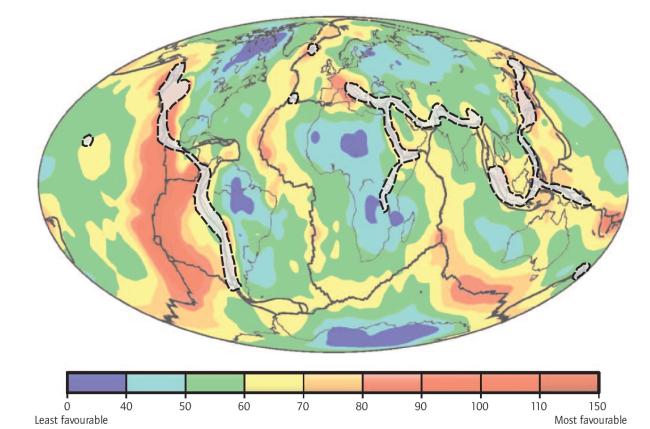
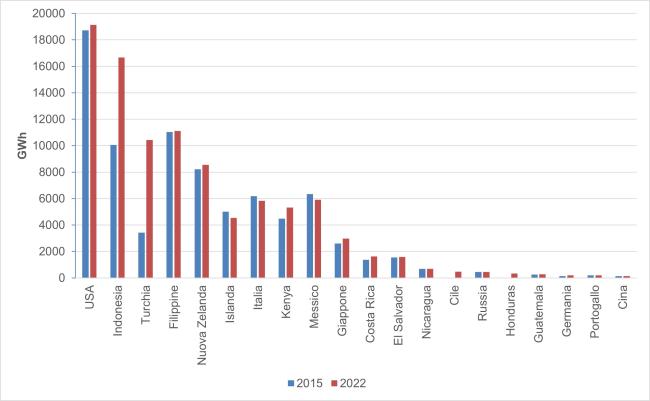
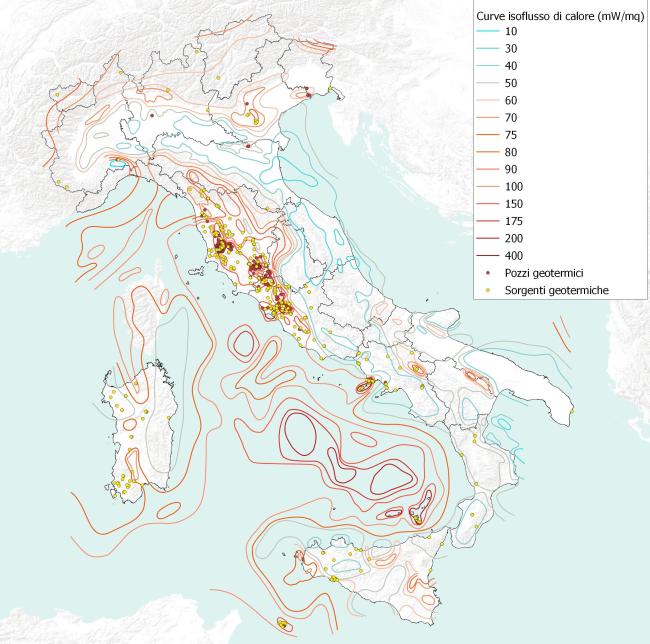


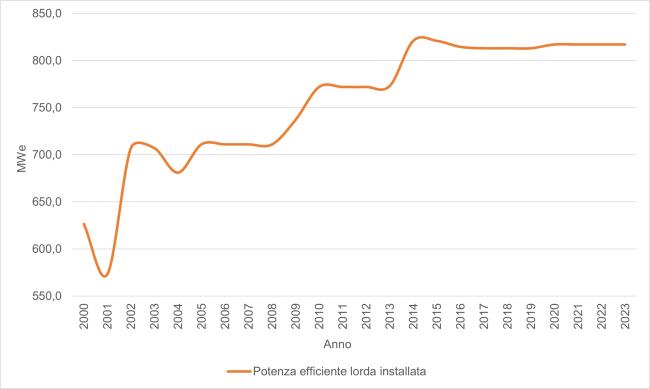


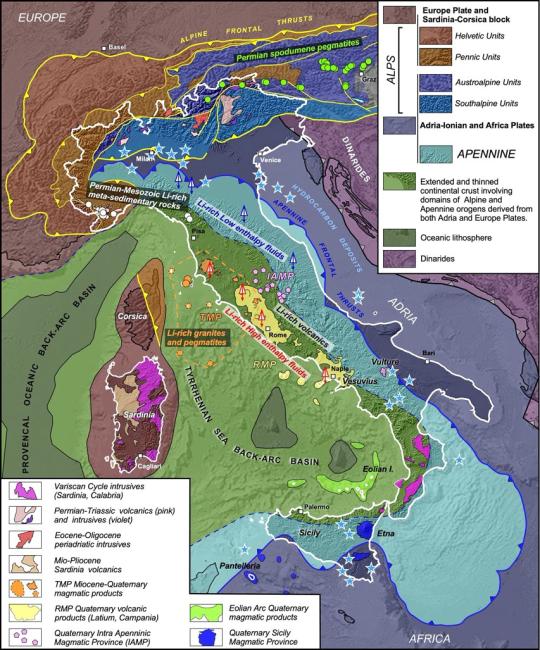
Each year the Earth releases energy equal to about 40TW, three times the amount needed for human energy demands. Only a portion of this energy is usable, and only a small part of that is actually harnessed. In most cases, the geothermal energy utilized is that associated with hydrothermal systems (conventional geothermal energy). In these cases, a hot magmatic body present at depth heats an aquifer, and the circulating water becomes the energy carrier (in liquid or gaseous phase) for heat transport to the surface, either spontaneously (fumaroles, steam vents, geysers, etc.) or through wells. Due to lithospheric dynamics, the highest values of terrestrial heat flow—and consequently conventional geothermal areas—are located where hot masses are closer to the surface, such as along plate margins, which are also associated with intense volcanism (Figures 1 and 2). In 2022, 22 countries worldwide generated about 100 billion kWh of electricity from geothermal energy (Figure 3).
For many years, the United States has led the ranking, partially exploiting the huge potential of the western coast, home to the largest and most famous geothermal field in the world, The Geysers. After being the cradle of geothermal energy production, with the world’s first plant built in Larderello in 1913 and world leader until the mid-20th century, Italy is currently ranked seventh in geothermal electricity production. Given its geological structure, Italy is a country with high geothermal potential. Geothermal fluids at sufficiently high temperatures for electricity production (medium and high enthalpy) are located in areas with high heat flow, corresponding to buried magmatic bodies and extinct or active volcanic systems, such as the coastal Tuscan-Lazio-Campania belt, the volcanic islands of the Tyrrhenian Sea, and the Etna area (Figure 4). Locally, as in Larderello and Monte Amiata, the heat flow reaches very high values. Conversely, medium-low enthalpy resources, suitable for direct uses (building heating, bathing, spa use, greenhouse farming, aquaculture, etc.) are found in many other areas of the national territory. With geothermal heat pumps, even low-temperature resources present almost everywhere and at shallow depths can be exploited. Geothermal resources covered by mining titles are concentrated in the Tuscan-Lazio area. Out of a national total of 36 concessions and research titles, 25 fall within Tuscany and 6 in Lazio (Figure 5, Table 1). Geothermal electricity production is exclusive to 10 concessions located in south-central Tuscany and concentrated in the Larderello and Monte Amiata zones (Figure 6). The concessions in Ferrara and Vicenza are related to direct use of geothermal resources (heating), while the concession in Valentano (Lazio) is not currently productive, nor is that of Poggio Montone (GR). Within the 10 Tuscan concessions, there are 34 plants (with 37 production sections) (Figure 6), 29 of which are "steam-dominated" in the Larderello and Radicondoli geothermal fields and 5 "water-dominated" in the Monte Amiata area, where the Bagnore3 plant houses the only currently operational binary group (Table 2). The total nominal capacity is 915.8 MW (Table 2), with a gross efficient capacity of 817.1 MW corresponding to a 2023 production of 5,692 GWh (Figures 7,8). Installed capacity has been stable since 2014 (Figure 7). Geothermal energy accounts for only 2.15% of national electricity production, but in Tuscany it represents about 36% of regional electricity production and meets more than 31% of regional needs (Table 3). Considering electricity production from RES, geothermal accounts for about 5% nationally but reaches 70% of Tuscany's production (Figure 9, Table 3). More widespread across the national territory are the direct uses of geothermal heat, whose main application is building climate control, including via geothermal heat pumps and district heating networks (Table 5). According to the EEA, building climate control represents 50% of European energy consumption, highlighting the significant contribution geothermal could make to reducing fossil fuel use. The use of geothermal sources for urban district heating networks is under development but, despite great potential, still represents only a small portion of energy sources used in Italian networks. The extensive use of geothermal heat pumps in Northern European countries clearly demonstrates the potential of this technology, which could also significantly contribute to residential heating in Italy, thereby reducing the use of fossil fuels and biomass. Although the number of geothermal heat pumps in Italy is steadily increasing, with about 20,000 units, it is still far from the figures seen in Northern Europe (Table 4). This figure is useful to define the order of magnitude of domestic systems but should be considered uncertified, pending the establishment of an official registry of geothermal heat pumps by the regions. Environmental impacts are limited to geothermal electricity uses but can be controlled through specific mitigation measures even in areas that, due to their geological nature, naturally release pollutants into the environment (e.g., through steam vents, fumaroles, geysers). Greenhouse gas emissions (carbon dioxide and methane) are not generated by the plants, which simply channel the gases present in geothermal fluids—gases that would otherwise be diffusely released into the atmosphere via the soil—into single emission points. Since there is no combustion, no fine particles or nitrogen oxides are emitted, while the channeled emissions of hydrogen sulfide and mercury are mitigated by AMIS abatement systems. Subsidence caused by fluid extraction is mitigated by water reinjection, while landscape impact can be limited by specific landscape architecture measures. Land use is significantly lower than other RES, especially photovoltaics. Induced seismicity, linked to high-pressure water injection to fracture rock, is characteristic of Enhanced Geothermal Systems (EGS), which are not in operation in Italy. Epidemiological surveys by ARS Toscana have not identified significant health impacts on populations from geothermal electricity production; however, in the Amiata area, further investigation is needed on the increase in blood and urinary concentrations of mercury, thallium, and arsenic, carefully considering the natural background levels in water and soil. Geothermal fluids can contain high quantities of elements essential for the entire green economy industry, such as lithium and rare earths, which can be suitably recovered. In particular, geothermal fluids in the peri-Tyrrhenian volcanic-geothermal zones (Tuscany-Lazio-Campania) show lithium concentrations up to 480 mg/l (Figure 10). These values are about double those found in the brines of California's Salton Sea geothermal field, considered by Americans as the source that will allow the U.S. to achieve independence from foreign lithium markets. Currently, 6 research permits have been issued in the Lake Bracciano area to assess the feasibility of the operation.